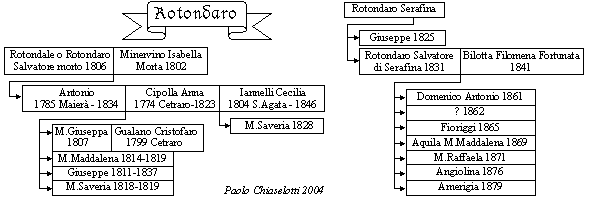
Nel 1811 e nel 1818 furono registrate le nascite di due bambini con cognome Rotondaro. Nel 1824 fu registrato il matrimonio di Maria Giuseppa Rotondaro, di anni diciassette, con Cristofaro Gualano. Tutti erano figli di Antonio e Cipolla Anna. Non sappiamo nient'altro di questa prima famiglia. Nel 1825 e nel 1831 abbiamo trovato gli atti di nascita di Giuseppe e di salvatore Rotondaro, figli di Serafina. Salvatore divenne muratore e nel 1858 sposò Filomena Fortunata Bilotta; ebbero sette figli, ma dopo il 1879, anno di nascita dell'ultimogenita, non abbiamo altre notizie.
Sappiamo che abitavano nel quartiere detto Costa di Fazzari. Il nome di Salvatore compare in una deliberazione del consiglio comunale che autorizzava il muratore ad occupare temporaneamente un suolo pubblico, negli atti del processo per sovversione nei moti del 1848 e nella Cronistoria della Città di San Marco Argentano per la partecipazione nel 1860 con il grado di sergente a due operazioni militari contro il governo borbonico.
The birth of a baby with last name Rotondaro was registered in 1811 and a second in 1818. In 1824 was registered the marriage of Maria Giuseppa Rotondaro, 17 years old, with Cristofaro Gualano. All they were sons of Antonio and Cipolla Anna. Nothing else we know about this first family.
In 1825 and 1831 we found the birth records of Giuseppe and Salvatore Rotondaro, sons of Serafina. Salvatore became a mason and in 1858 married Filomena Fortunata Bilotta; they had seven children but we did not find any information after 1879, birth-date of their last daughter.
We know that they were inhabiting in a place of the town named Costa di Fazzari. The name of Salvatore appears in a deliberation of the council of the town that authorized the mason to occupy temporarily a public site; in the deeds of the trial for subversion in the revolution of 1848, and in the History of the town of San Marco Argentano he mentioned for the participation as sergeant in two military actions against the Borbonic government.
In 1825 and 1831 we found the birth records of Giuseppe and Salvatore Rotondaro, sons of Serafina. Salvatore became a mason and in 1858 married Filomena Fortunata Bilotta; they had seven children but we did not find any information after 1879, birth-date of their last daughter.
We know that they were inhabiting in a place of the town named Costa di Fazzari. The name of Salvatore appears in a deliberation of the council of the town that authorized the mason to occupy temporarily a public site; in the deeds of the trial for subversion in the revolution of 1848, and in the History of the town of San Marco Argentano he mentioned for the participation as sergeant in two military actions against the Borbonic government.
